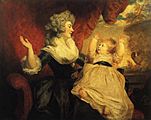Georgiana Cavendish, Duchess of Devonshire facts for kids
Quick facts for kids
The Duchess of Devonshire
|
|
|---|---|
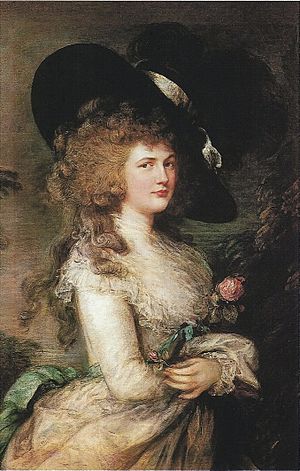
Portrait by Thomas Gainsborough
(18th century) |
|
| Born | Georgiana Spencer 7 June 1757 Althorp, Northamptonshire, England |
| Died | 30 March 1806 (aged 48) Devonshire House, Westminster, London, England |
| Buried | Derby Cathedral, Derbyshire |
| Noble family | Spencer (by birth) Cavendish (by marriage) |
| Spouse(s) |
William Cavendish, 5th Duke of Devonshire
(m. 1774) |
| Issue |
|
| Father | John Spencer, 1st Earl Spencer |
| Mother | Margaret Georgiana Poyntz |
| Occupation |
|
Georgiana Cavendish, Duchess of Devonshire (née Spencer; jor-JAY-nə; 7 June 1757 – 30 March 1806), was an English socialite and activist. Of noble birth from the Spencer family, married into the Cavendish family, she was the first wife of William Cavendish, 5th Duke of Devonshire, and the mother of the 6th Duke of Devonshire.
As the Duchess of Devonshire, she garnered much attention and fame in society during her lifetime. With a pre-eminent position in the peerage of England, the Duchess was famous for her charisma, political influence, beauty, unusual marital arrangement, love affairs, socializing, and gambling.
She was the great-great-great-great aunt of Diana, Princess of Wales. Their lives, centuries apart, have been compared in tragedy. She is also a great-great-great-aunt of Queen Elizabeth II by marriage through the queen's maternal grandmother.
Contents
Early life and family
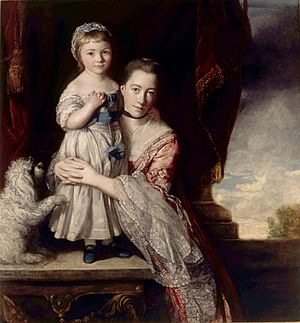
The Duchess was born Miss Georgiana Spencer, on 7 June 1757, as the first child of John Spencer (later Earl Spencer) and his wife, Georgiana (née Poyntz, later Countess Spencer), at the Spencer family home, Althorp. After her daughter's birth, her mother Lady Spencer wrote that "I will own I feel so partial to my Dear little Gee, that I think I never shall love another so well." Two younger siblings followed: Henrietta ("Harriet") and George. The daughter of her sister Henrietta, Lady Caroline Lamb, would become a writer and lover of Lord Byron. John Spencer, a great-grandson of John Churchill, 1st Duke of Marlborough, came from a wealthy English noble family. He built a Spencer family residence at St. James's, London, and raised his children there. The parents raised Georgiana and her siblings in a happy marriage. Georgiana grew to be close to her mother, who was said to favour Georgiana over her other children.
When her father assumed the title of Viscount Spencer in 1761, she became The Honourable Georgiana Spencer. In 1765, her father became Earl Spencer, and she Lady Georgiana Spencer.
Marriage and children
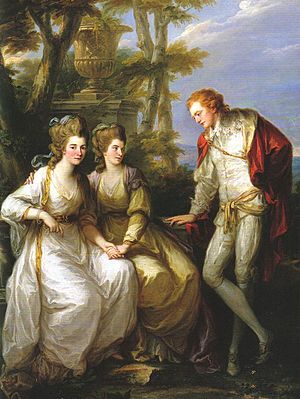
On her seventeenth birthday, 7 June 1774, Lady Georgiana Spencer was married to society's most eligible bachelor, William Cavendish, the 5th Duke of Devonshire (aged 25). The wedding took place at Wimbledon Parish Church. It was a small ceremony attended only by her parents, her paternal grandmother Lady Cowper, one of her prospective brothers-in-law, and her soon-to-be sister-in-law, the Duchess of Portland. Her parents were emotionally reluctant to let their daughter go, but she was wed to one of the wealthiest and most powerful men in the land. Her father, who had always shown affection to his children, wrote to her, "My Dearest Georgiana, I did not know till lately how much I loved you; I miss you more every day and every hour". Mother and daughter continued to correspond throughout their lives, and many of their letters survive.
From the beginning of the marriage, the Duke of Devonshire proved to be an emotionally reserved man who was quite unlike the Duchess's father and who did not meet the Duchess' emotional needs. The spouses also had little in common. He would seldom be at her side and would spend nights at Brooks's playing cards.
Before their marriage, the Duke had fathered a daughter, Charlotte Williams, with Charlotte Spencer (of no relation to the House of Spencer). This was unknown to the Duchess until years after her marriage to the Duke. After the death of the child's mother, the Duchess was compelled to raise Charlotte herself. The Duchess was "very pleased" with Charlotte, although her own mother Lady Spencer expressed disapproval: "I hope you have not talk'd of her to people". The besotted Georgiana replied, "She is the best humoured little thing you ever saw".
In 1782, while on a retreat from London with the Duke, the Duchess met Lady Elizabeth Foster (widely known as "Bess") in the City of Bath. She became close friends with Lady Elizabeth, who had become destitute after separating from her husband and two sons. Given the bond that developed between the two women (and the difficult position her new friend was in), with the Duke's acquiescence, the Duchess agreed to have Lady Elizabeth live with them permanently.
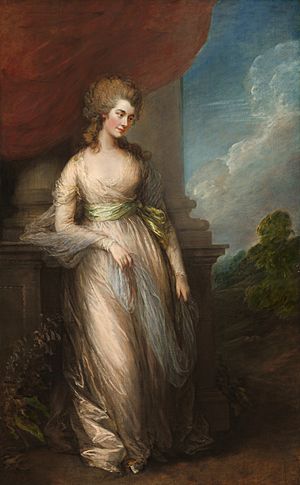
On 12 July 1783, Lady Georgiana Dorothy Cavendish, known as "Little G," was born. She would become the Countess of Carlisle and have her own issue. The Duchess had developed a strong mothering sentiment since raising Charlotte, and she insisted on nursing her own children (contrary to the aristocratic custom of having a wet nurse). On 29 August 1785, she gave birth to another daughter: Lady Harriet Elizabeth Cavendish, called "Harryo," who would become Countess Granville and also have children of her own. Finally, on 21 May 1790, the Duchess gave birth to a male heir to the dukedom: William George Spencer Cavendish, who took the title of Marquess of Hartington at birth, and was called "Hart." He would never marry and became known as "the bachelor duke."
With the birth of the Marquess of Hartington, the Duchess became romantically involved with Charles Grey (later Earl Grey), and bore him a child, Eliza Courtney, on 20 February 1792. The Duchess was forced to give away her daughter to Grey's family. She would later be allowed to pay visits to her daughter, providing her with presents and affection, and Eliza would grow up to marry Lieutenant-Colonel Robert Ellice and bear a daughter named Georgiana.
While in exile in France in the early 1790s, the Duchess of Devonshire suffered from isolation and felt her separation from her children. To return to England and her children, she conceded to her husband's demands and renounced her love for Charles Grey.
Character
Georgiana was generous, charismatic, good-humored, and intelligent. Kindhearted, Georgiana instinctively wanted to help others and from a young age, happily gave her money to poor children or her friends. Georgiana's empathy extended towards animals as well. After noticing a starving cow in a field, Georgiana deduced its owner could not afford to feed it, and so she had the man found and gave him some money.
Despite being extremely self-conscious and making strenuous effort to appear perfect, Georgiana "always appeared natural, even when she was called upon to open a ball in front of 800 people. She could engage in friendly chatter with several people simultaneously" and still made each person feel special. Widely described as almost impossible to dislike, Georgiana captured the hearts of almost everyone she met.
Pursuits and fame
With her renowned unconventional beauty and kind character, alongside her marriage to the affluent and powerful Duke of Devonshire, the Duchess of Devonshire was arguably the Diana, Princess of Wales of her time, as her popularity with the press and public can be compared to what her descendant experienced more than two hundred years later. Like Diana, every move Georgiana made was watched by spies around her and then reported on by the press, her every mistake made mockery of the next day in the papers.
Like her dear friend Marie Antoinette, the Duchess of Devonshire was one of the fashion icons of her time, and her keen sense made her the leader of fashion in England. Every outfit the Duchess wore, including her hairstyle, was immediately copied by the masses. The fashionable styling of her hair alone reached literally extraordinary heights above her exuberant costumes.
Using her influence as a leading socialite and fashion icon, the Duchess of Devonshire contributed to politics, science, and literature. As part of her illustrious social engagements, the Duchess would gather around her a large salon of literary and political figures. Among her major acquaintances were the most influential figures of her time, including the Prince of Wales (later King George IV); Marie Antoinette of France and her favourite in court, the Duchess of Polignac; Charles Grey (later Earl Grey and British Prime Minister); and Lady Melbourne (lover of the Prince of Wales).
Politics
The Spencer family, from which she derived, was an ardent supporter of the Whig party as were she and the Cavendish family. However, because the duke's high position in the peerage disallowed him from participating so commonly in politics, the duchess took it as a positive outlet for herself. In an age when the realisation of women's rights and suffrage were still more than a century away, the duchess became a political activist as the first woman to make active and influential front line appearances on the political scene. Having begun her involvement in politics in 1778 (when she inspired a mass of women to promote the Whig party), she relished enlightenment and Whig party ideals and took it upon herself to campaign—particularly for a distant cousin, Charles James Fox, who was chief party leader alongside Richard Brinsley Sheridan—for Whig policies which were anti-monarchy and advocated for liberty against tyranny.
At the time of her involvement, King George III (who detested the Whigs) and his ministers had a direct influence over the House of Commons, principally through their power of patronage. The Prince of Wales, who always relished going against the grain with his father, joined the Whig party when his friend, the duchess, became involved. She was renowned for hosting dinners that became political meetings, and she took joy in cultivating the company of brilliant radicals.
During the general election of 1784, the duchess became a major subject of scrutiny. Fanciful rumours and political cartoons circulated during the campaign, ridiculing her for securing votes in exchange for monetary rewards. Thomas Rowlandson even satirised her with a rumour of her trading kisses in his print "THE DEVONSHIRE, or Most Approved Method of Securing Votes". Her mother pleaded with her to step down. Still, the duchess was not daunted and was adamant in her activism. On election day, the Duchess of Devonshire walked the streets of London, even gaining blisters on her feet, meeting face-to-face with commoners as equals. She was instrumental in the success of Fox and Lord Hood. Still, after the extensive campaigning and negative media against her, she retired, after the win, from the political arena for a while. In 1788, she returned to political activism though behind the scenes.
Even in the last years of her life, she pushed ahead in the field and attempted to help rebuild the Whig party, which had become fragmented; her efforts were to no avail, and the political party would eventually come to dissolve decades after her death.
Literature
In her life, the Duchess was an avid writer and composed several works, of both prose and poetry, of which some were published.
She composed poetry as a young girl to her father, and some of it later circulated in manuscript. It was read by Walpole (who said it was "easy and prettily expressed, though it does not express much") and Reverend William Mason (who was more favorable with higher opinions).
The first of her published literary works was Emma; Or, The Unfortunate Attachment: A Sentimental Novel in 1773.
In 1778, the epistolary novel The Sylph was released. Although the book was published anonymously, the duchess is said to have privately admitted to her authorship. The Sylph was a success and underwent four reprintings.
One more piece was published in the last years of Georgiana's life, The Passage of the Mountain of Saint Gothard, first in an unauthorised version in the 'Morning Chronicle' and 'Morning Post' of 20 and 21 December 1799, then in a privately printed edition in 1800. A poem dedicated to her children, The Passage of the Mountain of Saint Gothard was based on her passage of the Saint Gotthard Pass, with Bess, between 10 and 15 August 1793 on returning to England. The thirty-stanza poem, together with 28 extended notes, were furthermore translated into some of the main languages of Western Europe including into French, by Jacques Delille, in 1802; Italian, by Gaetano Polidori, in 1803; and German in 1805. The Passage of the Mountain of Saint Gothard was then reprinted in 1816, after the duchess's death. Samuel Taylor Coleridge published a glowing response to the poem, 'Ode to Georgiana, Duchess of Devonshire' in the 'Morning Post' on 24 December 1799.
The 5th Duchess of Devonshire was connected to some of the greatest men of letters of her time, and Samuel Johnson, a famed writer of the era, had even paid a visit to the duke and duchess, in 1784, at their Chatsworth home.
Science
The Duchess had a small laboratory where she conducted chemistry experiments and studied geology, natural history and was most passionate for mineralogy. In addition to her scientific curiosity, the Duchess wanted to contribute to her children's education.
Her interest in science arose in part as she was related through marriage to the pneumatic chemist Henry Cavendish whose lab she visited in Clapham. The Duchess frequently engaged in scientific dialogue with prominent scientists of the era including Sir Charles Blagden, Professor Henri Struve, Horace Bénédict de Saussure, Sir Joseph Banks, Sir William Hamilton, Professor Gian Vincenzo Petrini, White Watson, Bryan Higgins, and Benjamin Thompson. Her knowledge of chemistry and mineralogy was regarded as genius as Thomas Beddoes wrote to Erasmus Darwin noting the Duchess, "manifested a knowledge of modern chemistry superior to that he should have supposed any duchess or lady in England was possessed of". Petrini, Blagden, and Henry Cavendish likewise contacted her mother Countess Spencer remarking upon the Duchess's aptitude, degree of knowledge she acquired, and extraordinary observations in the field of mineralogy. In pursuit of her interest, she hiked to the summit of Mount Vesuvius to observe and study the active crater and later began the Devonshire Mineral Collection at Chatsworth (the main seat of the dukes of Devonshire).
The Duchess played a key role in formulating, with Thomas Beddoes, the idea of establishing the Pneumatic Institution in Bristol. Her efforts to establish the Pneumatic Institute which advanced the study of factitious airs is an important event that provided framework for modern anesthesia as well as modern biomedical research in gasotransmitters.
Gambling
As was common among the aristocracy of her time, the Duchess routinely gambled for leisure and amusement. Her gaming spiraled into a ruinous addiction.
In the first years of her marriage, she accumulated debts that surpassed the 4,000 pounds that the Duke provided her annually as pin money. Her own mother disapproved and admonished her, unsuccessfully, to break her habit. After she had first incurred over 3,000 pounds in debt, the Duchess implored her parents to give her a loan as she absolutely would not inform her husband of her debts. Her parents acquiesced and told her to inform the duke, who nevertheless found out beforehand and repaid them.
For the rest of her life, the Duchess continued to amass an immense, ever-escalating debt that she always tried to keep hidden from her husband (even though he was among the richest men in the land). While she would admit to some amount, it was always less than the total, which even she could not keep up with. In confidence, she would ask for loans from the Prince of Wales.
Later life and death
After her return to England, the Duchess of Devonshire took a positive interest in science, took up writing again (producing two more works), and even continued her political activism while trying to rebuild the Whig party (to no avail before its end).
In 1796, she succumbed to illness in one eye; the medical treatment resulted in a scarring of her face.
During her early forties, the Duchess devoted her time to the coming out of her eldest daughter, Lady Georgiana Dorothy Cavendish, who wed Lord Morpeth, the heir apparent of the Earl of Carlisle, in 1801.
Her health continued to decline well into her forties. She died on 30 March 1806, at 3:30, at the age of 48. She was surrounded by her husband, the 5th Duke of Devonshire; her mother, Countess Spencer; her sister, the Countess of Bessborough; her eldest daughter, Lady Morpeth (who was eight months pregnant); and Lady Elizabeth Foster. They were all said to have been inconsolable over her death.
Thousands of the people of London congregated at Piccadilly, where the Cavendish family's town house was located, to mourn her. She was buried at the family vault at All Saints Parish Church (now Derby Cathedral) in Derby.
Legacy
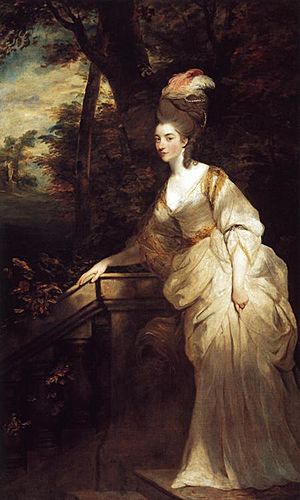
Immediately after her death, the Duke of Devonshire married Lady Elizabeth Foster, who became Duchess of Devonshire as his second wife.
Georgiana's children were discontented with the marriage as they never liked Lady Elizabeth at all. When William Cavendish, 5th Duke of Devonshire, died on 29 July 1811, the Marquess of Hartington became 6th Duke of Devonshire. Meanwhile, Lady Elizabeth fought to keep Cavendish properties to which she wasn't entitled. The 6th Duke of Devonshire finally oversaw an end to it all— he dismissed Lady Elizabeth by paying her off. Nevertheless, Georgiana's children lived the remainder of their lives with mutually positive relations with Lady Elizabeth Foster's children, having grown up together.
In 1786, Susanna Rowson, who went on to become a bestselling author, dedicated her first published work, Victoria, to the Duchess of Devonshire.
With the topic of liberation at the heart of policies she supported in life, the bold involvement of the Duchess of Devonshire in political activism pioneered women's public frontstage and influential participation in the field in a time before the validation of women's rights and subsequent feminist ideals.
Artwork representing the Duchess of Devonshire by reputable painters of the Georgian era remain, including a 1787 portrait by the famed Thomas Gainsborough which was once thought lost.
Over 1,000 personal letters written by the Duchess of Devonshire remain in existence. Chatsworth, the duke of Devonshire's seat, houses a majority of her letters in historical archives.
Film portrayals
- The Divine Lady (1929), portrayed by Evelyn Hall
- Berkeley Square (1933), portrayed by Juliette Compton
- The House in the Square (also titled I'll Never Forget You (US) and Man of Two Worlds) (1951), portrayed by Kathleen Byron
- The Duchess (2008), portrayed by Keira Knightley and directed by Saul Dibb, based on the biography Georgiana, Duchess of Devonshire by Amanda Foreman
Opera pasticcio
- ’’Georgiana’’ (2019), was commissioned by the Buxton Festival for its 40th anniversary, and was premièred there on 7 July 2019.
Works by Georgiana Cavendish
- Emma; Or, The Unfortunate Attachment: A Sentimental Novel (1773, )
- The Sylph (1778)
- The Passage of the Mountain of Saint Gothard (1799)
Gallery
-
The Duchess of Devonshire by Lady Diana Beauclerk, c. 1779
-
The Duchess of Devonshire by John Downman, c. 1780
-
The Duchess of Devonshire by Joshua Reynolds, c. 1780–81
-
The Duchess of Devonshire by Joshua Reynolds, 1786
See also
 In Spanish: Georgiana Cavendish para niños
In Spanish: Georgiana Cavendish para niños





